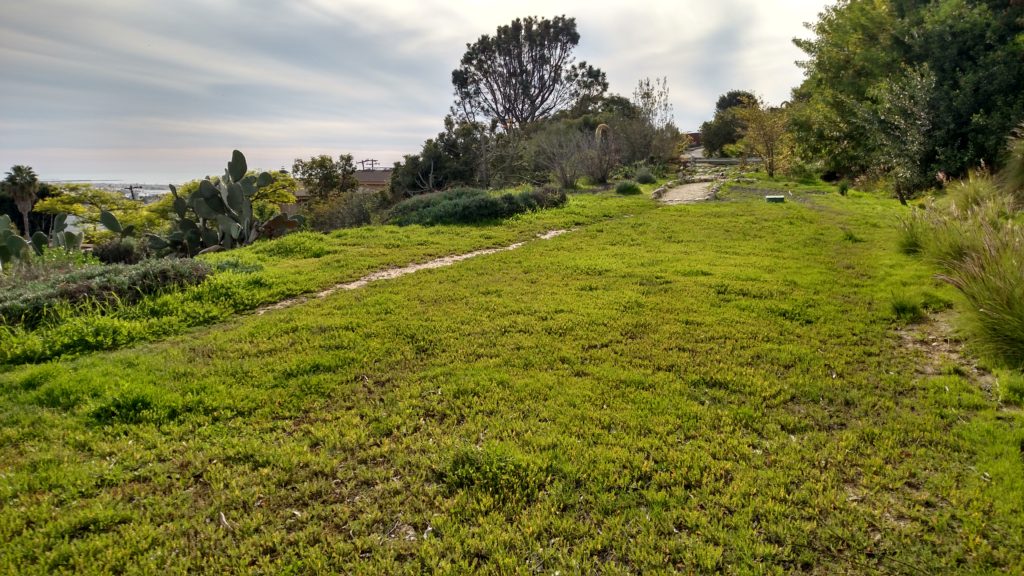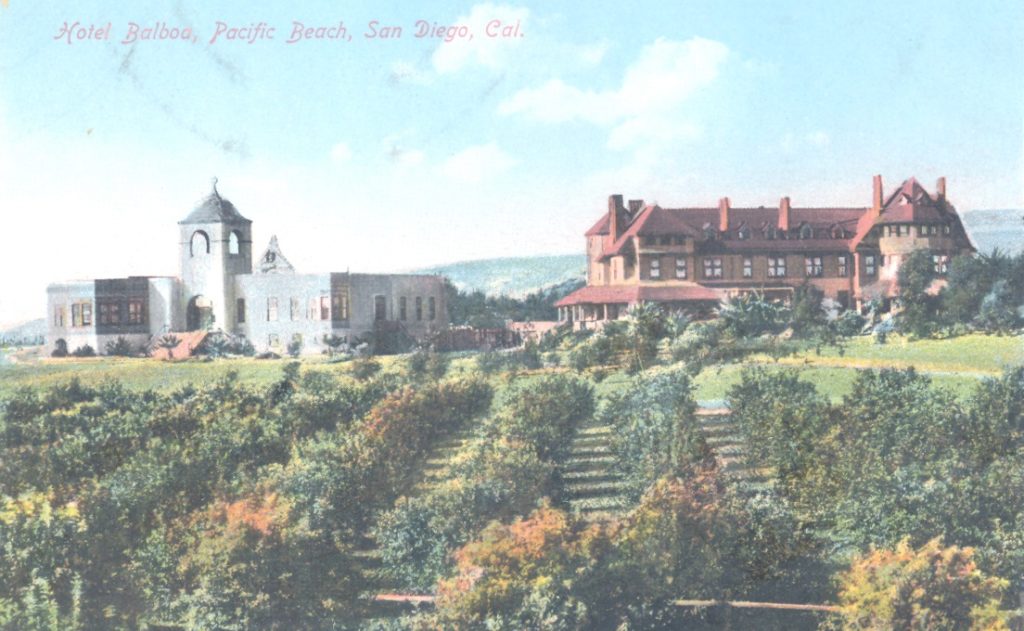Vacant lots and other undeveloped spots around Pacific Beach have turned a brilliant shade of green after a series of winter storms blew ashore in January. In 2019 these undeveloped spots are few and far between and the greenery is only apparent in isolated islands between streets, sidewalks and houses. It makes you wonder what it would have looked like before all the development occurred.
Actually, news reports from those early days did comment on the natural beauty of Pacific Beach after winter and spring rains. In January 1888 the only development in Pacific Beach was a hastily-constructed railway line built along what became Balboa Avenue. The line had been completed as far as Lamont Street in time to deliver more than 2500 people from San Diego to a hillside a couple of blocks north for the laying of the corner-stone of the San Diego College of Letters, the first substantial building in the month-old community. No one could have wished for a better January day, according to the San Diego Union; clouds were threatening rain in the morning but before the second train-load of excursionists reached Pacific Beach the sun had broken through the clouds and the green grass contributed to a sublime scene at the college campus. The San Diego Daily Bee added that the new campus was a lovely spot on a verdant slope. One of the speakers at the corner-stone ceremony also described the spring-like verdure, with the whole scene bathed in perennial sunshine. The college opened in September of 1888 but was not a success and closed in early 1891. The buildings remained, however, and were reopened in 1905 as the Hotel Balboa. A color (or colorized) post card from that time still shows a sublime scene of spring-like verdure bathed in sunshine (in 2019 the site is a parking lot at Pacific Plaza II).
When the college closed most of the academic community moved away but some remained and found the verdant slope surrounding the campus to be ideal for lemon cultivation. Several hundred acres were planted and in March 1895 a report in the Union stated that the lemon trees never looked finer nor made better growth. In other parts of Pacific Beach the fertile soil and winter rains combined to produce crops of grain and hay; the report in May 1895 was that hundreds of acres of grain were being harvested and the yield was good. The hillsides above the fields and orchards also benefited from the rain; the Union reported in February 1897 that ‘the hills and valleys hereabouts are clad in the most attractive emerald’.
Not every year was so ideal. In November 1897 men and teams and plows were said to be at work from daylight until dark getting ready to put in the seed for next year’s hay crop but in March 1898 the news was that although these grain-fields still looked green the need of rain was becoming very urgent. By August less than an inch of additional rain had fallen and the Union reported that the water situation was becoming serious. The ranches nearest the hillside were the greatest sufferers; the lemon ranches were irrigated but there was not enough water to supply the ranches at higher elevations. The Union’s Pacific Beach correspondent added that it was hoped that the experience of August 1873 would be repeated, when 1.95 inches of rain fell. However no rain did fall that August and only another quarter of an inch fell over the next three months.
1899 seemed destined to perpetuate the drought conditions in Pacific Beach. In March the news was that the seriousness of the water situation overshadowed every other topic. The service had been very insufficient for several days and the higher levels were feeling the situation very keenly. However in early May a delightful shower freshened the grass and trees wonderfully and a connection with a well in Rose Canyon had improved the water service. Showers in October were very welcome; the air was clear and beautiful and everyone seemed happy, not because a sufficient amount had fallen but because of the promise of more. By November 1899 the fields and hillsides were taking on the bountiful green so dear to all lovers of nature and O. J. Stough had nearly finished seeding 1200 acres to hay around the Beach.
Winter rains greeted the arrival of the twentieth century; the report from Pacific Beach in January 1900 was that the grain fields were beautiful and farmers said the prospects were never better. By March the grain was looking well since the rain and Pacific Beach ranches were a very pretty sight, the rich dark green of the orange trees mingled with the shades of the fruit from lightest green to deep yellow, contrasted with the pink and white of the peach blossoms. In April the ranches were busy picking lemons and the mowing machines were busy cutting O. J. Stough’s hay.
Although the young grain was looking well and pasture was good early in March 1901 another rain was ‘about due’. Apparently it did arrive on or around March 21, the date of the spring equinox. The report from Pacific Beach was that the ‘equinoctial’ rain was much needed and brought the grain along in fine shape (the correspondent added that arrangements should be made to have an equinox twice a month the whole year). The weather continued to be uncooperative, however. Most of the hay on the beach had been cut by mid-April 1901 but the Evening Tribune reported in late April that after holding off when it could have done the most good, a storm came ‘just in time to catch the new hay in the cocks so the farmers will have to fork it all over’ (ideally farmers ‘make hay while the sun shines’). The hay balers were back at work by the end of May and a quantity of hay was baled and shipped out.
The beneficial effects of winter rains became a common theme in the news from Pacific Beach in the new century. In January 1902 the Tribune reported that all the rain had soaked into the ground, which showed how very dry the earth must have been, but the hills had begun to show green and the lemon trees were looking well and were bearing heavily, with the promise of good price in the near future. A year later, in April 1903, the Union reported that recent rains had made fishing in False Bay (Mission Bay) very good, which kept the anglers busy when not employed in the orchards. The hay was all cut and most of it cured and the orchards were laden with bloom, not only with orange and lemon blossoms but with peach, pear and plum. Although 1903 and 1904 were relatively dry years, 1905 had the second highest annual rainfall ever recorded to that time in San Diego, over 16 inches. In June the Union reported that never had old Soledad been more lovely, with his mantle of variegated green and yellow, the tones of which vary with every hour of the day. The low-lying mesas between La Jolla and San Diego took on a more brilliant coat of red as many varieties of ice plant neared maturity and mingled with the long blooming sunshine flower.
O. J. Stough sold his holdings of over half the territory of Pacific Beach to Folsom Bros. Co. in November 1903. While Stough had plowed and seeded hundreds of acres of his land in the fall to harvest grain and cut hay in the spring, Folsom Bros. Co. was a real estate company that hoped to convert this undeveloped acreage into residential lots. By 1907 they were grading streets and pouring concrete sidewalks, and a subsidiary, Pacific Building Company, was incorporated to build homes for new lot owners. Lemon ranching had also gone into decline as eastern markets were increasingly supplied with lemons from across the Atlantic, particularly from Sicily, and some former lemon ranchers re-subdivided their land into residential lots. As more streets and sidewalks were paved and more houses built, fewer sublime scenes of variegated green were to be seen after winter rains (although the Union reported in 1908 that the people of Pacific Beach had been given a treat from Mother Nature in the fields of wild flowers that cover the hills back of the residence section).
The springtime displays continued to be noted for a few more years in the San Diego Union’s annual New Year’s day report of suburban communities. The Union wrote in 1918 that after the rainy season, which occurred in the winter months, the hills and every available spot in Pacific Beach were ablaze with wild flowers and all vegetation sprang into marvelous growth. No one could do justice to the advantages of living in this particular spot of Southern California. In 1922 the report was that the town occupied a site that might have been chosen by the gods. The setting was that of a beautiful picture in which no form of natural beauty had been omitted. To the north and east were green hills. ‘In such environs abide health and beauty. Hebe herself must have made this her dwelling place.’ (Hebe was the goddess of youth, and cupbearer for the gods and goddesses, serving their nectar and ambrosia).
Population growth and a new surge of residential development and street improvement following the war years of the 1940s eliminated most of the remaining open ground in central Pacific Beach, but for a while there were still green hills to the north and east in the springtime. When Kate Sessions Elementary School was opened at that corner of the community in 1956 this former student can remember a field of yellow mustard extending up the slope to a saddleback on the ridge. The development of Pacifica and Wesley Palms in 1960 replaced the green hills to the east, and the natural look of the hills to the north also disappeared as development continued up the slope of Mount Soledad. But even today, verdure can appear in undeveloped spots following winter rains; the San Diego Union-Tribune commented that the grass along local freeways had turned ‘greener than an Irish meadow’ after heavy rains in February 2019.

